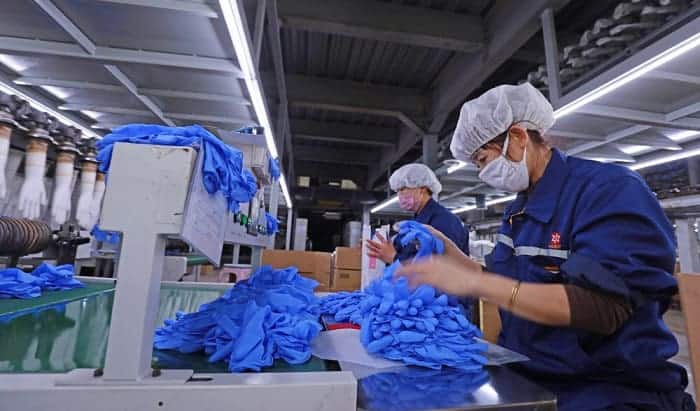A broad scope of tasks requires the use of nitrile gloves. So, if you wonder, “What are nitrile gloves used for?”, it might take some time for us to list all their benefits in various fields.
To make a quick summary about nitrile gloves, they are among the most commonly-used disposable hand protection gear. The product appears in chemicals, electronics, printing, dyeing, artistic fields like painting, and more.
If you want to know more about its utilization, here’re the details:
Table of Contents
What are Nitrile Gloves and Their Notable Features
Nitrile gloves are widespread, but that does not mean we can just use any pair for our duties. So, depending on the different working fields, we rely on specific kinds of gloves. Yet, nitrile gloves are famous for many practical features to protect and offer comfort for workers.
Latex-free – One important thing to know about disposable nitrile gloves is their latex-free formula. Thus, as synthetic rubber pairs, they are safe for use by and for people with allergies.
Chemical-resistant – These products are sufficient in keeping toxic agents and abrasive solutions from hurting our skins. Compared to other types of work gloves, the gear has superior protection against oil-based chemicals.
Puncture-resistant – Despite the thin design, nitrile gloves are incredibly robust. They are constructed to resist punctures caused by sharp tools or needles, making them qualified for medical uses.
Form-fitting and sensitive – One crucial factor when choosing gloves is the well-fitted size. And nitrile pairs rarely disappoint with their form-fitting design that embraces the users’ hands well. When wearing these gloves, we are guaranteed ultimate flexibility and sensitivity to perform intricate tasks.
Various colors – Of course, the colors on different nitrile gloves are not for show, as they are practical pairs for work. For instance, in processing food duties, they are color-coding to avoid contamination.
In detail, the law enforcement and postal employees often use black nitrile pairs for their tasks. Meanwhile, orange gloves are preferred by mechanics or automotive workers, as their hi-vis streams can aid work in low-light conditions.
Furthermore, medical workers utilize blue nitrile gloves, in which the light hue indicates latex-free formula. Lastly, employees in the food industry mostly use white nitrile gloves.
Anti-static – For workers handling tasks related to electricity, nitrile gloves with anti-static varieties are a must-have. They can reduce the static electricity in operating electronic components.
What are Nitrile Gloves Used for
With all those helpful functions, nitrile gloves are popular among different industries. Hence, they offer a wide range of uses, supporting workers in a safe duty every day.
- Medical work: Nitrile gloves are non-sterile pairs for medical examination. In other words, they are made for dentist check-ups due to hygiene requirements. With these disposable gloves, nurses in the health care section can prevent fluid transference while caring for their patients. Furthermore, you can see lots of pharmacists using blue nitrile pairs when handling prescribed medicines.
- Chemical manufacturing and laboratory work: The chemical and abrasive solvent resistance of these nitrile gloves makes them safe for workers in this field. These pairs ensure no direct exposure to toxic agents that damage our skin and health.
- Electronics, aerospace, and engineering – Puncture-resistant, anti-static, and oil-resistant gloves are required for work in these fields. Hence, employees that handle tasks with these risks can wear nitrile gloves to keep them safe. Furthermore, this pair’s high dexterity allows them to operate detailed tasks with sufficient freedom.
- Food processing and cooking – Both raw food and ready-to-eat meals should be handled with a high level of hygiene. A BPA-free and latex-free pair is required in such duties. That’s why people who hold food should wear nitrile gloves to keep the products clean and avoid contamination in the process.
What are Nitrile Gloves’ Qualifications
When choosing protective gloves for our tasks, it is essential to see their qualifications. With that, we can identify if the selected pair is certified to perform specific duties. Here’re some standards that we should look out for:
- EN 420 – This is the basic requirement for decent-quality safety gloves, including ones made of nitrile. The standard covers markings, dexterity level, innocuousness (pH level), and performance levels of the gloves.
- EN374- Nitrile gloves that meet EN 374 standards are produced with sufficient chemical resistance. They resist microorganisms and toxic chemicals with the EN 374-1. For gloves to resist penetration, they must meet the EN 374-2 standard. And the EN 374 -3 or EN 16523 ensures both qualifications about chemical and penetration blocking.
- EN 1186 – This glove regulation pimples that the gear is safe to be in direct contact with food. It has two primary limits to adhere to, including overall migration limit (OML) and specific migration limit (SML). An EN 1186-compliant pair is qualified to handle end food products.
Conclusion
While seeking the right pair of nitrile gloves for your work, you must know if it’s suitable or even qualified for the duties. So, it’s necessary to know “What are nitrile gloves used for?”
Once you are sure your chosen pair suffices, make sure to wear it often to protect your hands and skin from different hazards!

Hi, I am Alexander, forty-seven years old this year. I have been in the construction industry for twenty-five years and have provided a wide range of services. When it comes to expert guidance on site safety gear, you can put your trust in me.




